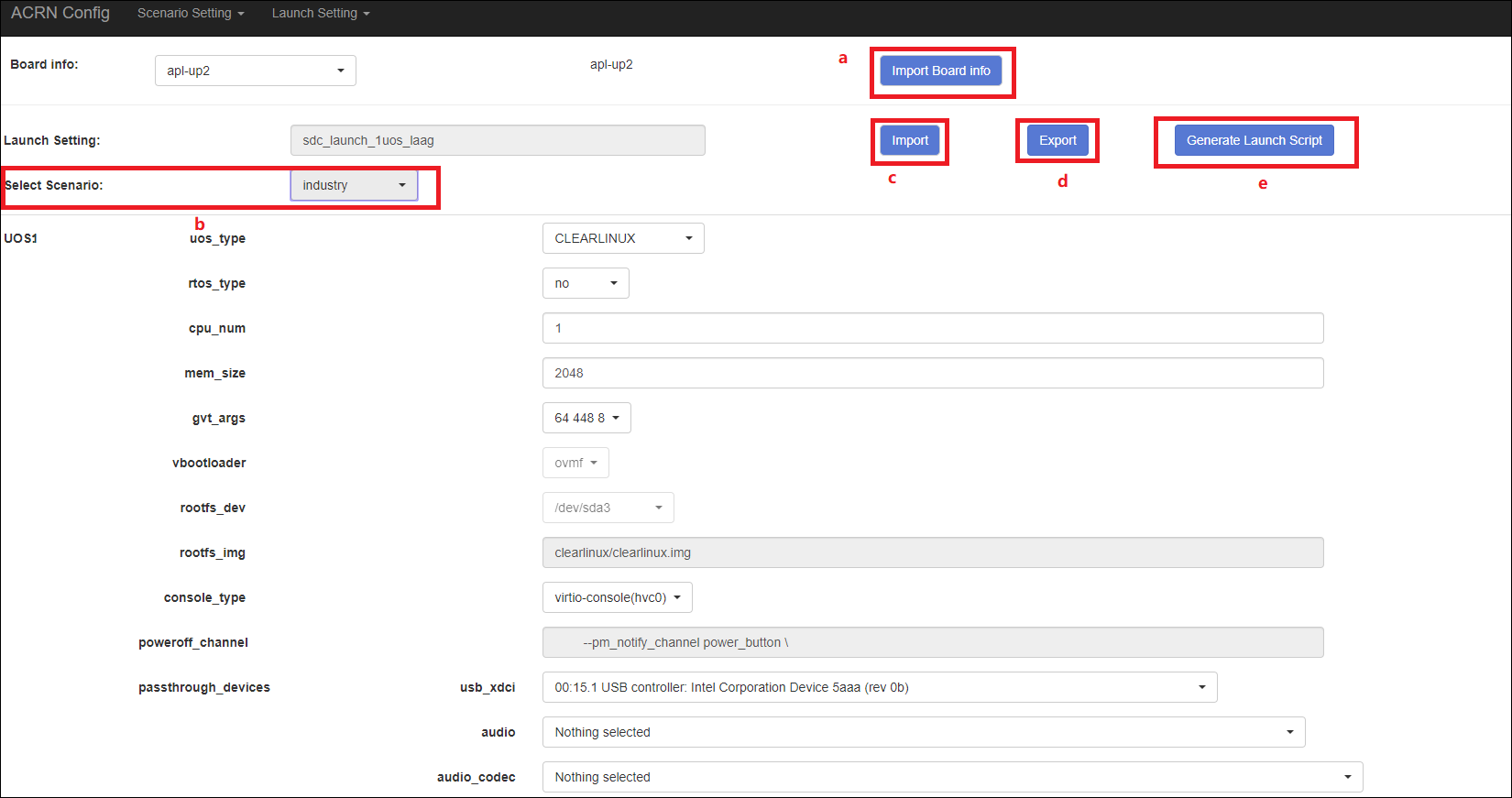ACRN Configuration Tool¶
The ACRN configuration tool is designed for System Integrators / Tier 1s to
customize ACRN to meet their own needs. It consists of two tools, the
Kconfig tool and the acrn-config tool. The latter allows users to
provision VMs via a web interface and configure the hypervisor from XML
files at build time.
Introduction¶
ACRN includes three types of configurations: Hypervisor, Board, and VM. Each are discussed in the following sections.
Hypervisor configuration¶
The hypervisor configuration defines a working scenario and target board by configuring the hypervisor image features and capabilities such as setting up the log and the serial port.
The hypervisor configuration uses the Kconfig mechanism. The configuration
file is located at acrn-hypervisor/hypervisor/arch/x86/Kconfig.
A board-specific defconfig file, for example
acrn-hypervisor/hypervisor/arch/x86/configs/$(BOARD).config
is loaded first; it is the default Kconfig for the specified board.
Board configuration¶
The board configuration stores board-specific settings referenced by the
ACRN hypervisor. This includes scenario-relevant information such as
board settings, root device selection, and the kernel cmdline. It also includes
scenario-irrelevant hardware-specific information such as ACPI/PCI
and BDF information. The reference board configuration is organized as
*.c/*.h files located in the
acrn-hypervisor/hypervisor/arch/x86/configs/$(BOARD)/ folder.
VM configuration¶
VM configuration includes scenario-based VM configuration information that is used to describe the characteristics and attributes for VMs on each user scenario. It also includes launch script-based VM configuration information, where parameters are passed to the device model to launch post-launched User VMs.
Scenario based VM configurations are organized as *.c/*.h files. The
reference scenarios are located in the
acrn-hypervisor/hypervisor/scenarios/$(SCENARIO)/ folder.
User VM launch script samples are located in the
acrn-hypervisor/devicemodel/samples/ folder.
ACRN configuration XMLs¶
The ACRN configuration includes three kinds of XML files for acrn-config
usage: board, scenario, and launch XML. All
scenario-irrelevant hardware-specific information for the board
configuration is stored in the board XML. The XML is generated by
misc/acrn-config/target/board_parser.py, which runs on the target
board. The scenario-relevant board and scenario-based VM configurations
are stored in the scenario XML. The launch script-based VM
configuration is stored in the launch XML. These two XMLs can be
customized by using the web interface tool at
misc/acrn-config/config_app/app.py. End users can load their own
configurations by importing customized XMLs or by saving the
configurations by exporting XMLs.
Board XML format¶
The board XMLs are located in the
acrn-hypervisor/misc/acrn-config/xmls/board-xmls/ folder.
The board XML has an acrn-config root element and a board attribute:
<acrn-config board="BOARD">
As an input for the acrn-config tool, end users do not need to care
about the format of board XML and should not modify it.
Scenario XML format¶
The scenario XMLs are located in the
acrn-hypervisor/misc/acrn-config/xmls/config-xmls/ folder. The
scenario XML has an acrn-config root element as well as board
and scenario attributes:
<acrn-config board="BOARD" scenario="SCENARIO">
Additional scenario XML elements:
hv:- Specify the global attributes for all VMs.
RELEASE(a child node ofDEBUG_OPTIONS):- Specify the final build is for Release or Debug.
SERIAL_CONSOLE(a child node ofDEBUG_OPTIONS):- Specify the host serial device is used for hypervisor debugging.
MEM_LOGLEVEL(a child node ofDEBUG_OPTIONS):- Specify the default log level in memory.
NPK_LOGLEVEL(a child node ofDEBUG_OPTIONS):- Specify the default log level for the hypervisor NPK log.
CONSOLE_LOGLEVEL(a child node ofDEBUG_OPTIONS):- Specify the default log level on the serial console.
LOG_DESTINATION(a child node ofDEBUG_OPTIONS):- Specify the bitmap of consoles where logs are printed.
LOG_BUF_SIZE(a child node ofDEBUG_OPTIONS):- Specify the capacity of the log buffer for each physical CPU.
RELOC(a child node ofFEATURES):- Specify whether hypervisor image relocation is enabled on booting.
SCHEDULER(a child node ofFEATURES):- Specify the CPU scheduler used by the hypervisor.
Supported schedulers are:
SCHED_NOOP,SCHED_BVTandSCHED_IORR. MULTIBOOT2(a child node ofFEATURES):- Specify whether ACRN hypervisor image can be booted using multiboot2 protocol. If not set, GRUB’s multiboot2 is not available as a boot option.
HYPERV_ENABLED(a child node ofFEATURES):- Specify whether Hyper-V is enabled.
IOMMU_ENFORCE_SNP(a child node ofFEATURES):- Specify whether IOMMU enforces snoop behavior of DMA operation.
ACPI_PARSE_ENABLED(a child node ofFEATURES):- Specify whether ACPI runtime parsing is enabled..
L1D_VMENTRY_ENABLED(a child node ofFEATURES):- Specify whether L1 cache flush before VM entry is enabled.
MCE_ON_PSC_DISABLED(a child node ofFEATURE):- Specify whether force to disable software workaround for Machine Check Error on Page Size Change is enabled.
STACK_SIZE(a child node ofMEMORY):- Specify the size of stacks used by physical cores. Each core uses one stack for normal operations and another three for specific exceptions.
HV_RAM_SIZE(a child node ofMEMORY):- Specify the size of the RAM region used by the hypervisor.
LOW_RAM_SIZE(a child node ofMEMORY):- Specify size of RAM region below address 0x10000, starting from address 0x0.
SOS_RAM_SIZE(a child node ofMEMORY):- Specify the size of Service OS VM RAM region.
UOS_RAM_SIZE(a child node ofMEMORY):- Specify the size of User OS VM RAM region.
PLATFORM_RAM_SIZE(a child node ofMEMORY):- Specify the size of the physical platform RAM region.
IOMMU_BUS_NUM(a child node ofCAPACITIES):- Specify the highest PCI bus ID used during IOMMU initialization.
MAX_IR_ENTRIES(a child node ofCAPACITIES):- Specify the maximum number of Interrupt Remapping Entries.
MAX_IOAPIC_NUM(a child node ofCAPACITIES):- Specify the maximum number of IO-APICs.
MAX_PCI_DEV_NUM(a child node ofCAPACITIES):- Specify the maximum number of PCI devices.
MAX_IOAPIC_LINES(a child node ofCAPACITIES):- Specify the maximum number of interrupt lines per IOAPIC.
MAX_PT_IRQ_ENTRIES(a child node ofCAPACITIES):- Specify the maximum number of interrupt source for PT devices.
MAX_MSIX_TABLE_NUM(a child node ofCAPACITIES):- Specify the maximum number of MSI-X tables per device.
MAX_EMULATED_MMIO(a child node ofCAPACITIES):- Specify the maximum number of emulated MMIO regions.
GPU_SBDF(a child node ofMISC_CFG):- Specify the Segment, Bus, Device, and function of the GPU.
UEFI_OS_LOADER_NAME(a child node ofMISC_CFG):- Specify the UEFI OS loader name.
vm:- Specify the VM with VMID by its “id” attribute.
vm_type:Current supported VM types are:
SAFETY_VMpre-launched Safety VMPRE_STD_VMpre-launched Standard VMSOS_VMpre-launched Service VMPOST_STD_VMpost-launched Standard VMPOST_RT_VMpost-launched realtime capable VMKATA_VMpost-launched Kata Container VM
name(a child node ofvm):- Specify the VM name shown in the hypervisor console command: vm_list.
guest_flags:Select all applicable flags for the VM:
GUEST_FLAG_SECURE_WORLD_ENABLEDspecify whether secure world is enabledGUEST_FLAG_LAPIC_PASSTHROUGHspecify whether LAPIC is passed throughGUEST_FLAG_IO_COMPLETION_POLLINGspecify whether the hypervisor needs IO polling to completionGUEST_FLAG_HIDE_MTRRspecify whether to hide MTRR from the VMGUEST_FLAG_RTspecify whether the VM is RT-VM (realtime)
cpu_affinity:- List of pCPU: the guest VM is allowed to create vCPU from all or a subset of this list.
base(a child node ofepc_section):- SGX EPC section base; must be page aligned.
size(a child node ofepc_section):- SGX EPC section size in bytes; must be page aligned.
clos:- Class of Service for Cache Allocation Technology settings. Refer to RDT Allocation Feature Supported by Hypervisor for details.
start_hpa(a child node ofmemory):- The start physical address in host for the VM.
size(a child node ofmemory):- The memory size in bytes for the VM.
name(a child node ofos_config):- Specify the OS name of VM; currently, it is not referenced by the hypervisor code.
kern_type(a child node ofos_config):- Specify the kernel image type so that the hypervisor can load it correctly.
Currently supports
KERNEL_BZIMAGEandKERNEL_ZEPHYR. kern_mod(a child node ofos_config):- The tag for the kernel image that acts as a multiboot module; it must exactly match the module tag in the GRUB multiboot cmdline.
ramdisk_mod(a child node ofos_config):- The tag for the ramdisk image which acts as a multiboot module; it must exactly match the module tag in the GRUB multiboot cmdline.
bootargs(a child node ofos_config):- For internal use and is not configurable. Specify the kernel boot arguments in bootargs under the parent of board_private.
kern_load_addr(a child node ofos_config):- The loading address in host memory for the VM kernel.
kern_entry_addr(a child node ofos_config):- The entry address in host memory for the VM kernel.
vuart:- Specify the vuart (A.K.A COM) with the vUART ID by its “id” attribute. Refer to Enable vUART Configurations for detailed vUART settings.
type(a child node ofvuart):- vUART (A.K.A COM) type, currently only supports the legacy PIO mode.
base(a child node ofvuart):- vUART (A.K.A COM) enabling switch. Enable by exposing its COM_BASE (SOS_COM_BASE for Service VM); disable by returning INVALID_COM_BASE.
irq(a child node ofvuart):- vCOM irq.
target_vm_id(a child node ofvuart1):- COM2 is used for VM communications. When it is enabled, specify which target VM the current VM connects to.
target_uart_id(a child node ofvuart1):- Target vUART ID that vCOM2 connects to.
pci_dev_num:- PCI devices number of the VM; it is hard-coded for each scenario so it is not configurable for now.
pci_devs:- PCI devices list of the VM; it is hard-coded for each scenario so it is not configurable for now.
board_private:- Stores scenario-relevant board configuration.
rootfs(a child node ofboard_private):- rootfs for the Linux kernel.
bootargs(a child node ofboard_private):- Specify kernel boot arguments.
Launch XML format¶
The launch XMLs are located in the
acrn-hypervisor/misc/acrn-config/xmls/config-xmls/ folder.
The launch XML has an acrn-config root element as well as
board, scenario and uos_launcher attributes:
<acrn-config board="BOARD" scenario="SCENARIO" uos_launcher="UOS_NUMBER">
Attributes of the uos_launcher specify the number of User VMs that the
current scenario has:
uos:- Specify the User VM with its relative ID to Service VM by the “id” attribute.
uos_type:- Specify the User VM type, such as
CLEARLINUX,ANDROID,ALIOS,PREEMPT-RT LINUX,GENERIC LINUX,WINDOWS,ZEPHYRorVXWORKS. rtos_type:- Specify the User VM Realtime capability: Soft RT, Hard RT, or none of them.
mem_size:- Specify the User VM memory size in Mbyte.
gvt_args:- GVT arguments for the VM. Set it to
gvtdfor GVTd, otherwise stand for GVTg arguments. The GVTg Input format:low_gm_size high_gm_size fence_sz, The recommendation is64 448 8. Leave it blank to disable the GVT. vbootloader:- Virtual bootloader type; currently only supports OVMF.
vuart0:- Specify whether the device model emulates the vUART0(vCOM1); refer to
Enable vUART Configurations for details. If set to
Enable, the vUART0 is emulated by the device model; if set toDisable, the vUART0 is emulated by the hypervisor if it is configured in the scenario XML. poweroff_channel:- Specify whether the User VM power off channel is through the IOC, Powerbutton, or vUART.
usb_xhci:- USB xHCI mediator configuration. Input format:
bus#-port#[:bus#-port#: ...], e.g.:1-2:2-4. Refer to USB Virtualization for details. passthrough_devices:- Select the passthrough device from the lspci list; currently we support: usb_xdci, audio, audio_codec, ipu, ipu_i2c, cse, wifi, Bluetooth, sd_card, ethernet, wifi, sata, and nvme.
network(a child node ofvirtio_devices):- The virtio network device setting.
Input format:
tap_name,[vhost],[mac=XX:XX:XX:XX:XX:XX]. block(a child node ofvirtio_devices):- The virtio block device setting.
Input format:
[blk partition:][img path]e.g.:/dev/sda3:./a/b.img. console(a child node ofvirtio_devices):- The virtio console device setting.
Input format:
[@]stdio|tty|pty|sock:portname[=portpath][,[@]stdio|tty|pty:portname[=portpath]].
Note
The configurable and readonly attributes are used to mark
whether the items is configurable for users. When configurable="0"
and readonly="true", the item is not configurable from the web
interface. When configurable="0". the item does not appear on the
interface.
Configuration tool workflow¶
Hypervisor configuration workflow¶
The hypervisor configuration is based on the Kconfig
mechanism. Begin by creating a board-specific defconfig file to
set up the default Kconfig values for the specified board.
Next, configure the hypervisor build options using the make
menuconfig graphical interface or make defconfig to generate
a .config file. The resulting .config file is
used by the ACRN build process to create a configured scenario- and
board-specific hypervisor image.
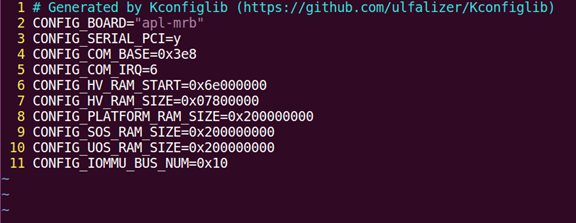
Figure 24 defconfig file sample
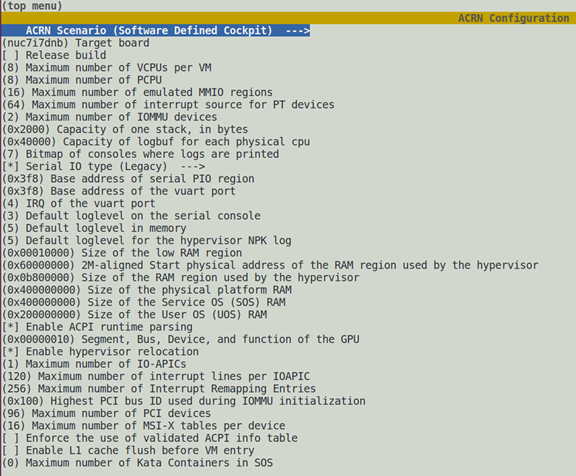
Figure 25 menuconfig interface sample
Refer to Build the hypervisor configuration for detailed configuration steps.
Board and VM configuration workflow¶
Python offline tools are provided to configure Board and VM configurations.
The tool source folder is acrn-hypervisor/misc/acrn-config/.
Here is the offline configuration tool workflow:
Get the board info.
Set up a native Linux environment on the target board.
Copy the
targetfolder into the target file system and then run thesudo python3 board_parser.py $(BOARD)command.A $(BOARD).xml that includes all needed hardware-specific information is generated in the
./out/folder. (Here$(BOARD)is the specified board name)Native Linux requirement:Release: Ubuntu 18.04+ or Clear Linux 30210+Tools: cpuid, rdmsr, lspci, dmidecode (optional)Kernel cmdline: “idle=nomwait intel_idle.max_cstate=0 intel_pstate=disable”
Customize your needs.
- Copy
$(BOARD).xmlto the host development machine. - Run the
misc/acrn-config/config_app/app.pytool on the host machine and import the $(BOARD).xml. Select your working scenario under Scenario Setting and input the desired scenario settings. The tool will do a sanity check on the input based on the $(BOARD).xml. The customized settings can be exported to your own $(SCENARIO).xml. - In the configuration tool UI, input the launch script parameters for the post-launched User VM under Launch Setting. The tool will sanity check the input based on both the $(BOARD).xml and $(SCENARIO).xml and then export settings to your $(LAUNCH).xml.
- The user defined XMLs can be imported by acrn-config for modification.
Note
Refer to Use the ACRN configuration app for more details on the configuration tool UI.
- Copy
Auto generate the code.
Python tools are used to generate configurations in patch format. The patches are applied to your local
acrn-hypervisorgit tree automatically.Generate a patch for the board-related configuration:
cd misc/acrn-config/board_config python3 board_cfg_gen.py --board $(BOARD).xml --scenario $(SCENARIO).xml
Note that this can also be done by clicking Generate Board SRC in the acrn-config UI.
Generate a patch for scenario-based VM configuration:
cd misc/acrn-config/scenario_config python3 scenario_cfg_gen.py --board $(BOARD).xml --scenario $(SCENARIO).xml
Note that this can also be done by clicking Generate Scenario SRC in the acrn-config UI.
Generate the launch script for the specified post-launched User VM:
cd misc/acrn-config/launch_config python3 launch_cfg_gen.py --board $(BOARD).xml --scenario $(SCENARIO).xml --launch $(LAUNCH).xml --uosid xx
Note that this can also be done by clicking Generate Launch Script in the acrn-config UI.
Re-build the ACRN hypervisor. Refer to Build ACRN from Source to re-build the ACRN hypervisor on the host machine.
Deploy VMs and run ACRN hypervisor on the target board.
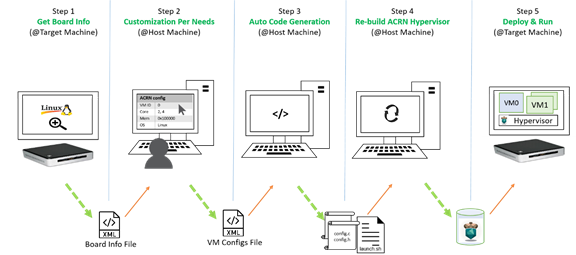
Figure 26 Offline tool workflow
Use the ACRN configuration app¶
The ACRN configuration app is a web user interface application that performs the following:
- reads board info
- configures and validates scenario settings
- automatically generates source code for board-related configurations and scenario-based VM configurations
- configures and validates launch settings
- generates launch scripts for the specified post-launched User VMs.
- dynamically creates a new scenario setting and adds or deletes VM settings in scenario settings
- dynamically creates a new launch setting and adds or deletes User VM settings in launch settings
Prerequisites¶
Clone acrn-hypervisor:
$git clone https://github.com/projectacrn/acrn-hypervisor
Install ACRN configuration app dependencies:
$ cd ~/acrn-hypervisor/misc/acrn-config/config_app $ sudo pip3 install -r requirements
Instructions¶
Launch the ACRN configuration app:
$ python3 app.py
Open a browser and navigate to the website http://127.0.0.1:5001/ automatically, or you may need to visit this website manually. Make sure you can connect to open network from browser because the app needs to download some JavaScript files.
Note
The ACRN configuration app is supported on Chrome, Firefox, and MS Edge. Do not use IE.
The website is shown below:
Set the board info:
Click Import Board info.

Upload the board info you have generated from the ACRN config tool.
After board info is uploaded, you will see the board name from the Board info list. Select the board name to be configured.

Load or create the scenario setting by selecting among the following:
- Choose a scenario from the Scenario Setting menu which lists all user-defined scenarios for the board you selected in the previous step.
- Click the Create a new scenario from the Scenario Setting menu to dynamically create a new scenario setting for the current board.
- Click the Load a default scenario from the Scenario Setting menu, and then select one default scenario setting to load a default scenario setting for the current board.
The default scenario configuration xmls are located at
acrn-hypervisor/misc/acrn-config/xmls/config-xmls/[board]/. We can edit the scenario name when creating or loading a scenario. If the current scenario name is duplicated with an existing scenario setting name, rename the current scenario name or overwrite the existing one after the confirmation message.
Note that you can also use a customized scenario xml by clicking Import XML. The configuration app automatically directs to the new scenario xml once the import is complete.
The configurable items display after one scenario is created/loaded/ selected. Following is an industry scenario:
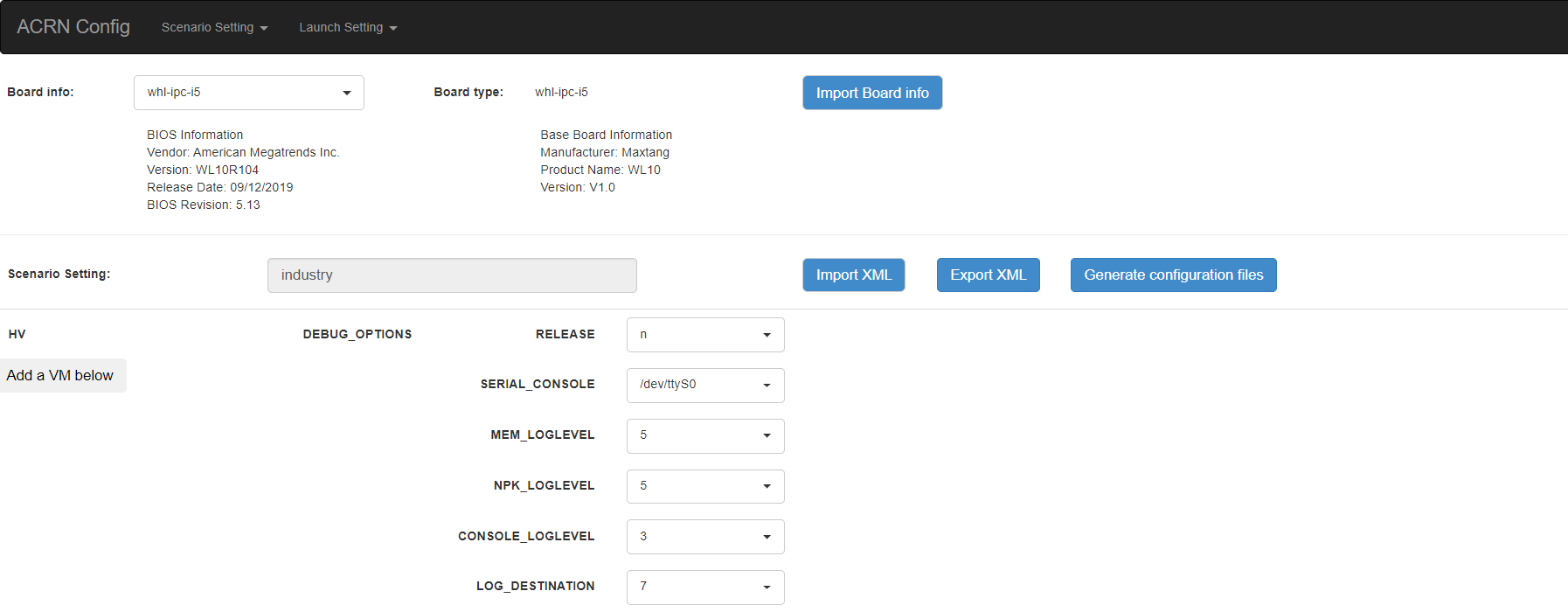
- You can edit these items directly in the text boxes, or you can choose single or even multiple items from the drop down list.
- Read-only items are marked as grey.
- Hover the mouse pointer over the item to display the description.
To dynamically add or delete VMs:
- Click Add a VM below in one VM setting, and then select one VM type to add a new VM under the current VM.
- Click Remove this VM in one VM setting to remove the current VM for the scenario setting.
When one VM is added or removed in the scenario setting, the configuration app reassigns the VM IDs for the remaining VMs by the order of Pre-launched VMs, Service VMs, and Post-launched VMs.

Click Export XML to save the scenario xml; you can rename it in the pop-up model.
Note
All customized scenario xmls will be in user-defined groups which are located in
acrn-hypervisor/misc/acrn-config/xmls/config-xmls/[board]/user_defined/.Before saving the scenario xml, the configuration app validates the configurable items. If errors exist, the configuration app lists all incorrect configurable items and shows the errors as below:

After the scenario is saved, the page automatically directs to the saved scenario xmls. Delete the configured scenario by clicking Export XML -> Remove.
Click Generate configuration files to save the current scenario setting and then generate files for the board-related configuration source code and the scenario-based VM configuration source code.
If Source Path in the pop-up model is edited, the source code is generated into the edited Source Path relative to
acrn-hypervisor; otherwise, the source code is generated into default folders and overwrite the old ones. The board-related configuration source code is located atacrn-hypervisor/hypervisor/arch/x86/configs/[board]/and the scenario-based VM configuration source code is located atacrn-hypervisor/hypervisor/scenarios/[scenario]/.
The Launch Setting is quite similar to the Scenario Setting:
Upload board info or select one board as the current board.
Load or create one launch setting by selecting among the following:
- Click Create a new launch script from the Launch Setting menu.
- Click Load a default launch script from the Launch Setting menu.
- Select one launch setting xml from the menu.
- Importing the local launch setting xml by clicking Import XML.
Select one scenario for the current launch setting from the Select Scenario drop down box.
Configure the items for the current launch setting.
To dynamically add or remove User VM (UOS) launch scripts:
- Add a UOS launch script by clicking Configure an UOS below for the current launch setting.
- Remove a UOS launch script by clicking Remove this VM for the current launch setting.
Save the current launch setting to the user-defined xml files by clicking Export XML. The configuration app validates the current configuration and lists all incorrect configurable items and shows errors.
Click Generate Launch Script to save the current launch setting and then generate the launch script.
